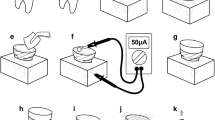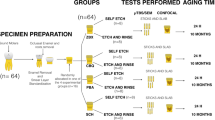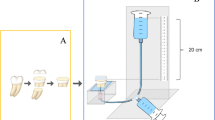Abstract
Objectives
This study evaluates the dentin infiltration ability of various types of adhesives and compares four classes of adhesive systems with regard to this property. The infiltration is determined quantitatively, characterized as tag length and ratio of infiltration, and qualitatively, characterized as homogeneity, regularity, and continuity of the resin tags.
Materials and methods
Flat dentin surfaces from 140 halves of caries-free molars were bonded with four classes of adhesive systems. The adhesives (n = 20) were labeled with rhodamine B isothiocyanate and applied on the occlusal dentin following the manufacturer’s recommendations and were subsequently light cured, 20 s. Then a 2-mm thick composite layer was applied and light cured, 20 s. The specimens were stored in distilled water at 37°C, 24 h. Two slices were sectioned mesio–distally from each sample and were investigated with a confocal laser scanning microscope. The measurements were done at 0.5, 1.5, and 2.5 mm from the enamel–dentin junction. The data were analyzed by using analysis of variance and the general linear model.
Results
The class of adhesive, the composition, and the dentin position were significant factors affecting the investigated parameters. The use of etch and rinse adhesives in comparison to self-etch adhesives provided the formation of longer, more homogeneous, very regularly distributed but mostly fractured tags.
Conclusions
A comparison of adhesives confirmed that etch and rinse systems remain better in bond infiltration.
Clinical relevance
While the importance of tags formation on bonding is still controversially discussed, adhesive systems with a high ratio of infiltration might better protect the tooth against microorganism contamination.



Similar content being viewed by others
References
Van Meerbeek B, Yoshihara K, Yoshida Y, Mine A, De Munck J, Van Landuyt KL (2011) State of the art of self-etch adhesives. Dent Mater 27:17–28
Nakabayashi N, Kojima K, Masuhara E (1982) The promotion of adhesion by the infiltration of monomers into tooth substrates. J Biomed Mater Res 3:265–273
Van Meerbeek B, Inokoshi S, Braem M, Lambrechts P, Vanherle G (1992) Morphological aspects of the resin-dentin interdiffusion zone with different dentin adhesive systems. J Dent Res 71:1530–1540
Perdigão J (2010) Dentin bonding-variables related to the clinical situation and the substrate treatment. Dent Mater 26:e24–e37
Levinkind M, Vandernoot TJ, Elliott JC (1992) Evaluation of smear layers on serial sections of human dentin by means of electrochemical impedance measurements. J Dent Res 71:426–433
Van Meerbeek B, Vargas S, Inoue S, Yoshida Y, Peumans M, Lambrechts P, Vanherle G (2001) Adhesives and cements to promote preservation dentistry. Oper Dent 26:s119–s144
Van Meerbeek B, De Munck J, Yoshida Y, Inoue S, Vargas M, Vijay P, Van Landuyt K, Lambrechts P, Vanherle G (2003) Buonocore memorial lecture. Adhesion to enamel and dentin: current status and future challenges. Oper Dent 3:215–235
Peumans M, Kanumilli P, De Munk J, Van Landuyt K, Lambrechts P, Van Meerbeck B (2005) Clinical effectiveness of contemporary adhesives: a systematic review of current clinical trials. Dent Mater 21:861–881
Albaladejo A, Osorio R, Toledano M, Ferrari M (2010) Hybrid layers of etch-and-rinse adesive systems versus self-etching adhesive systems. Med Oral Patol Oral Cir Bucal 15:e112–e118
Tam LE, Pilliar RM (1994) Fracture surface characterization of dentin-bonded interfacial fracture toughness specimens. J Dent Res 3:607–619
Van Meerbeek B, Peumans M, Verschuren M, Gladys S, Braem M, Lambrechts P, Vanherle G (1994) Clinical status of ten dentin adhesive systems. J Dent Res 73:1690–1701
Giachetti L, Bertini F, Russo Scaminaci D (2004) Investigation into the nature of dentin resin tags: a scanning electron microscopic morphological analysis of demineralized bonded dentin. J Prosthet Dent 92:233–238
Tao L, Pashley DH (1988) Shear bond strength to dentin: effects of surface treatment, depth and position. Dent Mater 4:371–378
Gwinett AJ (1993) Quantitative contribution of resin infiltration/hybridation to dentin bonding. Am J Dent 6:7–9
Nakabayashi N (1985) Bonding of restorative materials to dentin: the present status in Japan. Int Dent J 35:145–154
Dagostin A, Ferrari M (2001) In vivo bonding mechanism of an experimental dual-cure enamel–dentin bonding system. J Dent 14:105–108
De Munck J, Van Landuyt KL, Peumans M, Poitevin A, Lambrechts P, Braem M, Van Meerbeek B (2005) A critical review of the durability of adhesion to tooth tissue: methods and results. J Dent Res 84:118–132
De Munck J, Van Meerbeeck, B., Yoshida, Y., Inoue, S., Vargas, M., Suzuki, K., et al. (2003) Four-year water degradation of total-etch adhesives bonded to dentin. J Dent Res
Olalekan AA-Y, Driessen CH, Botha AJ (2005) SEM–EDX study of prepared human dentine surfaces exposed to gingival retraction fluids. J Dent 33:731–739
Van Landuyt K, De Munck J, Coutinho E, Peumans M, Lambrechts P, Van Meerbeek B (2005) Smear layer and the process of hybridization. In: Eliades G, Watts DC, Eliades T (eds) Dental hard tissues and bonding interfacial phenomena and related properties. Springer, Berlin, pp 89–122
Bitter K, Paris S, Pfuertner C, Neumann K, Kielbassa AM (2009) Morphological and bond strength evaluation of different resin cements to root dentin. Eur J Oral Sci 117:326–333
Pioch T, Stotz S, Staehle HJ, Duschner H (1997) Applications of confocal laser scanning microscopy to dental bonding. Adv Dent Res 11:453–461
D’Alpino PHP, Pereira CJ, Svizero NR, Rueggeberg FA, Pashley D (2006) Use a fluorescent compounds in assessing bonded resin-based restorations: a literature review. J Dent 34:623–634
Watson TF (1997) Fact and artefact in confocal microscopy. Adv Dent Res 11:433–440
Sidhu SK, Watson TF (1998) Interfacial characteristics of resin-modified glass-ionomer materials: a study on fluid permeability using confocal fluorescence microscopy. J Dent Res 77:1749–1759
De Munck J, Vargas M, Iracki J, Van Landuyt KL, Poitevin A, Lambrechts P, Van Meerbeek B (2005) One-day bonding effectiveness of new self-etch adhesives to bur-cut enamel and dentin. Oper Dent 30:39–49
Pashley DH, Tay FR, Breschi L, Tjäderhane L, Carvalho RM, Carrilho M, Tezvergil-Mutluay A (2011) State of the art etch-and-rinse adhesives. Dent Mater 27:1–16
Van Landuyt KL, Peumans M, De Munck J, Lambrechts P, Van Meerbeeck B (2006) Extension of a one-step self-etch adhesive into a multi-step adhesive. Dent Mater 22:533–544
Mine A, De Munck J, Cardoso M, Van Landuyt KL, Poitevin A, Kuboki T, Yoshida Y, Suzuki K, Lambrechts P, Van Meerbeek B (2009) Bonding effectiveness of two contemporary sef-etch adhesives to enamel and dentin. J Dent 36:767–773
Margvelashvili M, Goracci C, Beloica M, Papacchini F, Ferrari M (2010) In vitro evaluation of bonding effectiveness to dentin of all-in-one adesives. J Dent 38:106–112
Celiberti P, Lussi A (2005) Use of self-etching adhesive on previously etched intact enamel and its effect on sealant microleakage and tag formation. J Dent 33:163–171
Santini A, Miletic V (2008) Comparison of the hybrid layer formed by Silorane adhesive, one-step self-etch and etch and rinse systems using confocal micro-Raman spectroscopy and SEM. J Dent 36:683–691
Banu Ermis R, De Munck J, Cardoso MV, Coutinho E, Van Landuyt KL, Poitevin A, Lambrechts P, Van Meerbeek B (2008) Bond strength of self-etch adhesives to dentin prepared with three different diamond burs. Dent Mater 24:978–985
Tay FR, Pashley DH (2001) Aggressiveness of contemporary self-etching systems. I: Depth of penetration beyond dentin smear layers. Dent Mater 4:296–308
Van Meerbeek B, Yoshida Y, Lambrechts P, Vanherle G, Duke ES, Eick JD et al (1998) A TEM study of two water-based adhesive systems bonded to dry and wet dentin. J Dent Res 77:50–59
Manso A, Luiz Marquezini Jr SMAS, Pashley D, Tay FR, Carvahlo MR (2008) Stability of wet versus dry bonding with different solvent-based adhesives. Dent Mater 4:476–482
Latta MA (2007) Shear bond strength and physicochemical interactions of XP Bond. J Adhes Dent 9:245–248
Kugel G, Ferrari M (2000) The science of bonding: from first to sixth generation. J Am Dent Assoc 131:20S–25S
Pashley DH (1991) Clinical correlation of dentin structure and function. J Prosthet Dent 66:777–781
Duke ES, Lindemuth J (1991) Variability of clinical dentin substrates. Am J Dent 4:241–246
Knobloch L, Gailey D, Azer Sh, Johnston W, Clelland N, Kerby R (2007) Bond Strength of one- and two-step self-etch adhesive systems. J Prosthet Dent 97:216–222
Peumans M, De Munck J, Van Landuyt KL, Poitevin A, Lambrechts P, Van Meerbeek B (2010) Eight-year clinical evaluation of a 2-step self-etch adhesive with and without selective enamel etching. Dent Mater 26:1176–1184
Koshiro K, Inoue S, Sano H, De Munck J, Van Meerbeek B (2005) In vivo degradation of resin-dentin bonds produced by a self-etch and an etch-and-rinse adhesive. Eur J Oral Sci 4:341–348
Inoue S, Koshiro K, Yoshida Y, De Munck J, Nagakane K, Suzuki K, Sano H, Van Meerbeek B (2005) Hydrolytic stability of self-etch adhesives bonded to dentin. J Dent Res 12:1160–1164
Conflict of interest
The authors declare that they have no conflict of interest.
Author information
Authors and Affiliations
Corresponding author
Rights and permissions
About this article
Cite this article
Langer, A., Ilie, N. Dentin infiltration ability of different classes of adhesive systems. Clin Oral Invest 17, 205–216 (2013). https://doi.org/10.1007/s00784-012-0694-4
Received:
Accepted:
Published:
Issue Date:
DOI: https://doi.org/10.1007/s00784-012-0694-4




